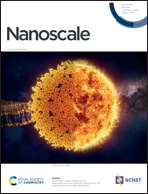Accelerated size-focusing light activated synthesis of atomically precise fluorescent Au22(Lys–Cys–Lys)16 clusters†
Abstract
Atomically precise metal nanoclusters are promising candidates for various biomedical applications, including their use as photosensitizers in photodynamic therapy (PDT). However, typical synthetic routes of clusters often result in complex mixtures, where isolating and characterizing pure samples becomes challenging. In this work, a new Au22(Lys–Cys–Lys)16 cluster is synthesized using photochemistry, followed by a new type of light activated, accelerated size-focusing. Fluorescence excitation–emission matrix spectroscopy (EEM) and parallel factor (PARAFAC) analysis have been applied to track the formation of fluorescent species, and to assess optical purity of the final product. Furthermore, excited state reactivity of Au22(Lys–Cys–Lys)16 clusters is studied, and formation of type-I reactive oxygen species (ROS) from the excited state of the clusters is observed. The proposed size-focusing procedure in this work can be easily adapted to conventional cluster synthetic methods, such as borohydride reduction, to provide atomically precise clusters.



 Please wait while we load your content...
Please wait while we load your content...